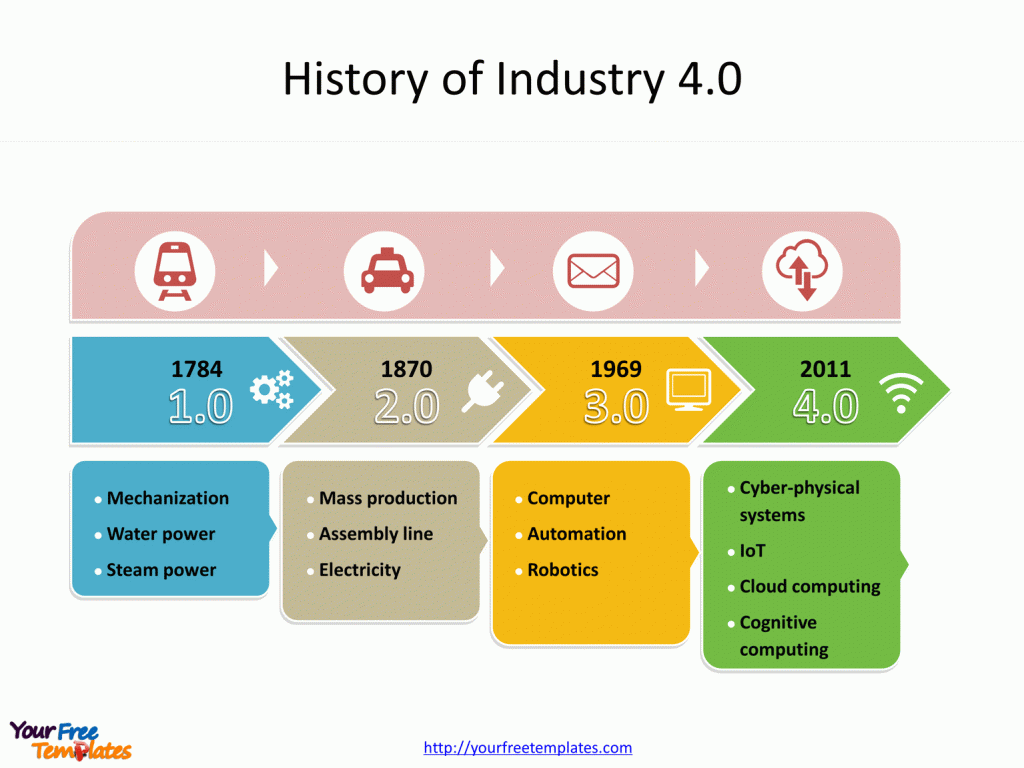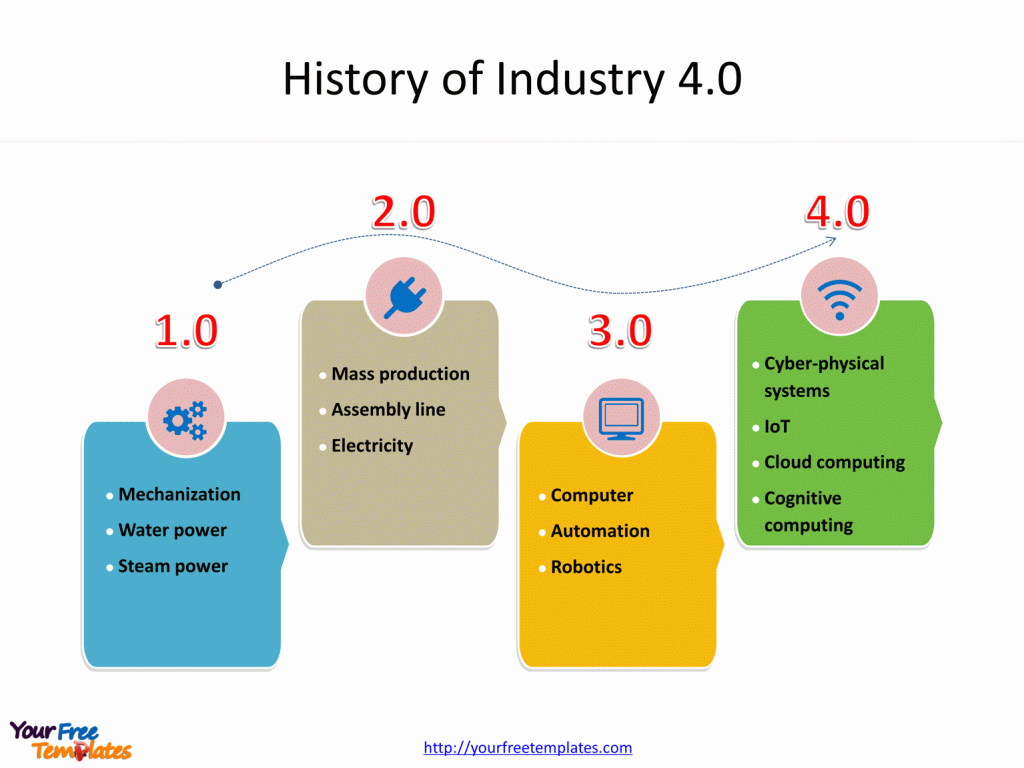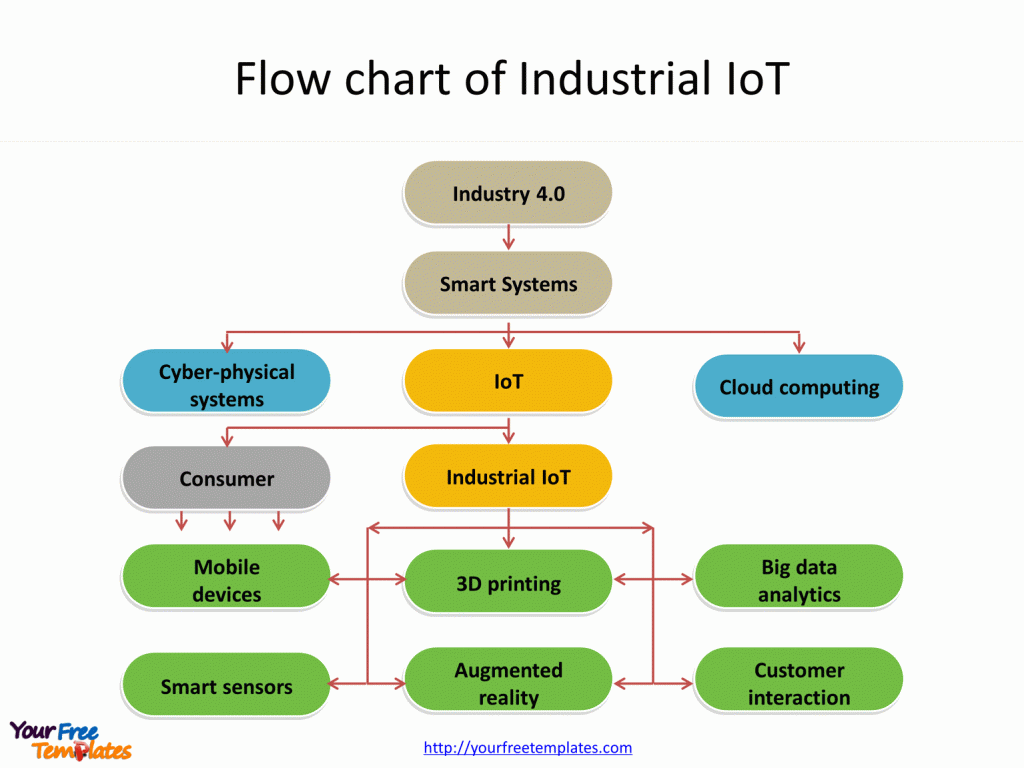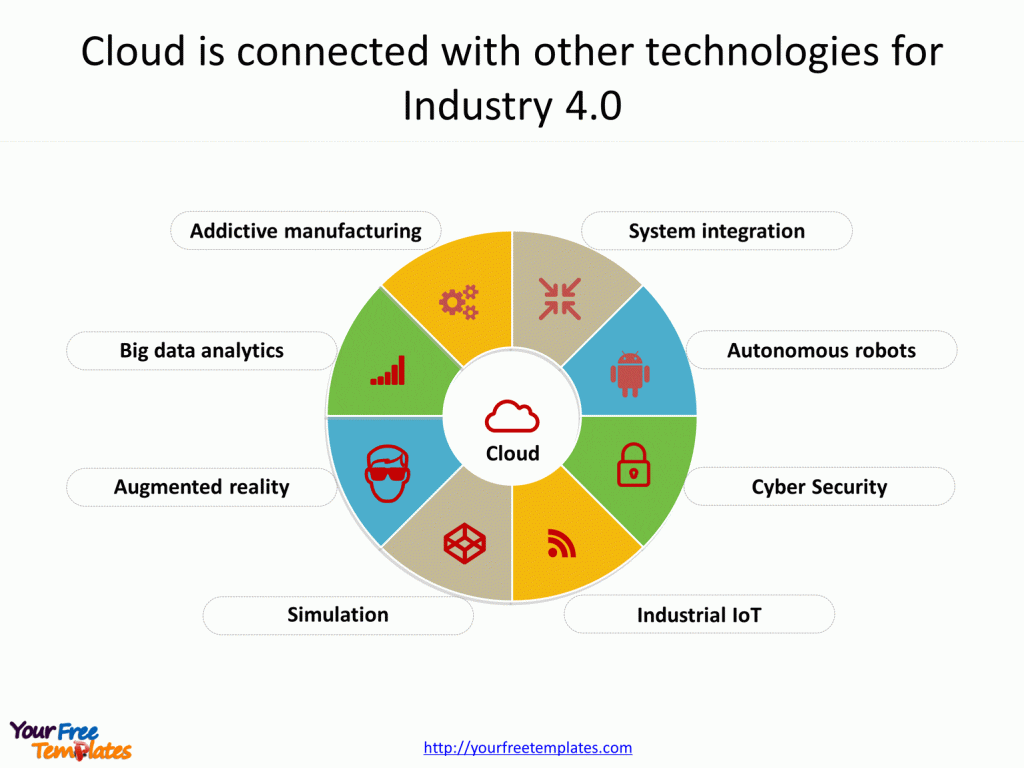The Industry 4.0 Template in PowerPoint format include four slides. Firstly we have 4th industrial revolution template. Secondly we present Industrial IoT with flow chart. Finally you can enjoy the cloud with various technologies for Industry 4.0. As the same diagram PowerPoint template series, you can also find our Data Mining, Machine Learning, cloud computing, Artificial Intelligence and BlockChain PowerPoint templates.
Industry 4.0 represents a significant shift in the global industrial landscape, marking the current trend towards automation and data exchange in manufacturing technologies and processes. This transformative phase integrates the digital and physical worlds through a network of devices, systems, and people, leading to the creation of smart factories.
Slide 1, Industry 4.0 history template
Definition and Core Components
At its core, Industry 4.0 leverages advanced technologies to create highly efficient, automated, and self-monitoring production processes. These technologies include:
The internet of things (IoT) Platforms: IoT platforms serve as the backbone of Industry 4.0, enabling the connection and communication between machines, sensors, and people in real-time. This connectivity allows for the collection and exchange of vast amounts of data, facilitating decision-making processes and optimizing operations.
Cloud computing: Cloud computing offers scalable resources and powerful computing capabilities on-demand, enabling businesses to store and analyze large datasets without the need for substantial on-site infrastructure. This flexibility is crucial for the adaptability and scalability of manufacturing processes.
Big Data Analytics: The ability to analyze vast quantities of data in real-time is pivotal for identifying patterns, predicting maintenance needs, and optimizing production processes. Big data analytics provides the insights needed to drive efficiency and innovation.
Artificial Intelligence (AI) and Machine Learning: AI and machine learning algorithms can predict outcomes, automate complex processes, and adapt to changing conditions with minimal human intervention. These technologies are crucial for enhancing decision-making and operational efficiency in smart factories.

Slide 2, Industry 4.0 history template two
From Industry 1.0 to 4.0: A Brief History
The evolution from Industry 1.0 to 4.0 represents the continuous innovation in industrial practices over the centuries:
- Industry 1.0 marked the transition from hand production methods to machines during the late 18th century, powered by water and steam.
- Industry 2.0 emerged in the early 20th century, characterized by mass production and assembly lines, powered by electricity.
- Industry 3.0 began in the 1970s with the introduction of computers and automation in manufacturing processes.
- Industry 4.0 builds on the foundation of Industry 3.0, integrating IoT, AI, cloud computing, and big data analytics to create interconnected and intelligent systems.

Slide 3, Flow chart of Industry 4.0
Industrial revolution 4.0 fosters what has been called a “smart factory”. Within modular structured smart factories, cyber-physical systems monitor physical processes, create a virtual copy of the physical world and make decentralized decisions. Over the Internet of Things, cyber-physical systems communicate and cooperate with each other and with humans in real-time both internally and across organizational services offered and used by participants of the value chain.

The Integration of Technologies in Industry 4.0
The true power of Industry 4.0 lies in the integration of its core technologies, where cloud computing plays a pivotal role. Cloud platforms serve as the central hub for data collected from IoT devices, enabling real-time data analysis with big data analytics and decision-making processes powered by AI. This interconnectedness allows for unprecedented levels of efficiency, flexibility, and customization in manufacturing.
Slide 4, Cloud is connected with other technologies for Industry 4.0
For instance, predictive maintenance, powered by AI algorithms analyzing data from IoT sensors, can anticipate equipment failures before they occur, reducing downtime and maintenance costs. Similarly, big data analytics can optimize supply chains, predicting demand patterns and automating inventory management, ensuring timely and cost-effective delivery of materials.
Moreover, cloud computing facilitates the collaboration and sharing of resources across global manufacturing networks, enabling companies to leverage expertise and infrastructure from around the world. This global integration fosters innovation, accelerates product development, and enhances competitiveness.

Conclusion
Industry 4.0 represents a paradigm shift in manufacturing, characterized by the integration of digital technologies into all aspects of production. The synergy between IoT, cloud computing, big data analytics, and AI is driving unprecedented levels of efficiency, flexibility, and innovation, ushering in a new era of smart manufacturing. As industries continue to embrace these technologies, the principles of Industry 4.0 will become increasingly integral to achieving sustainable growth and competitive advantage in the global marketplace.
Looking for Premium maps, please visit our affiliate site: https://editablemaps.com/ or https://ofomaps.com/
Size:123K
Type: PPTX
Aspect Ratio: Standard 4:3
Click the blue button to download it.
Download the 4:3 Template
Aspect Ratio: Widescreen 16:9
Click the green button to download it.
Download the 16:9 Template











